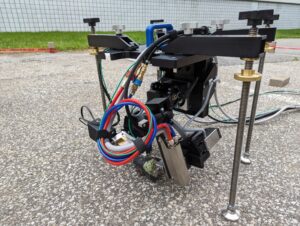Working with industry partner Proto Manufacturing, Earth sciences professor Roberta Flemming and team members on the Canadian Space Agency-funded project successfully tested a miniaturized in situ X-ray diffractometer (ISXRD) last month in LaSalle, Ont.
The prototype version of the ISXRD, built by Proto. (Roberta Flemming)
An X-ray diffractometer is a standard laboratory instrument used around the world to characterize minerals – but until now there was no hand-held version of such a device that could be used to analyze minerals in situ, in-person remotely on-site.
Minerals tell us about the history of a rock, and the environmental conditions that existed when it formed. For example, using the ISXRD, scientists could potentially study the role that water played in forming minerals on Mars.
“There is only one diffractometer anywhere in the solar system that is off Earth and that is CheMin (Chemistry and Mineralogy) on the Curiosity rover,” said Flemming, a planetary minerologist and faculty member at Western’s Institute for Earth and Space Exploration. “It uses a drill to powder or pulverize the rock samples, scoops them up and analyzes the material inside the machine.”
That process is too slow and lacks context (due to fragmentation and possible contamination) says Flemming, so she proposed a miniaturized version of a traditional laboratory diffractometer that could characterize the geology of the Martian surface using an external system for targeting remotely, and more precise X-ray analysis strategies.
Mitacs-funded student intern Dana Beaton, co-supervised by Flemming and electrical and computer engineering professor Jayshri Sabarinathan, and Proto product development manager Stanislav Veinberg, designed a prototype version of the ISXRD. It was built by Proto and mounted as a standalone instrument as part of a simulated rover mission. The functionality of the instrument was tested during the analogue mission in LaSalle on October 12-13, on rocks similar to those that would be found on Mars.

Earth sciences professor Livio Tornabene (left) and Western Space research officer Eric Pilles observe data returns from the field test with student Lauren McFarlane at the mission controls in the Physics & Astronomy Building. (Roberta Flemming)
At Western, a team of faculty, staff and students sent commands to the simulated rover in LaSalle to target and analyze these rocks. Team members in the field carried out activities to simulate rover movements.
“The test mission was a huge success and worked better than we hoped,” said Flemming. “And partnering with Proto was critical to the success because they knew how to build the machine. We knew what we wanted, and they knew how to make it a reality.”
The researchers from Western and Proto used the ISXRD to characterize various rock samples, including gypsum, mudstone, basalt containing a mantle xenolith (cooled magma) and breccia. Data was acquired on the ISXRD in as little as 17 minutes per target.
“It’s a very complicated design because critically, you have to get the science right, but you also have to make it small, which means less power,” said Flemming. “When you try and scale down something for space that normally fits in a lab, you have to figure out a way to power it with a lot less energy. And you have to make it robust enough that it could survive the launch and landing, and small enough to mount on a rover arm, but sophisticated enough to move the way we need it to move.”
The project is funded by a Canadian Space Agency grant through its Flights and Fieldwork for the Advancement of Science and technology (FAST) initiative. The Mars analogue rocks used for characterization by the ISXRD instrument were provided by researchers from Western, Brock University and University of Guelph.
“Working closely with Dr. Flemming and her team at Western has been a great experience. The prospect of the ISXRD system eventually collecting data on Mars is very exciting, and it has inspired me to push the boundaries of creativity in the creation of future Proto systems,” said Veinberg. “At Proto, we always strive to design innovative new products for our customers in the powder diffraction world, and collaborating with a team that is so committed and knowledgeable about their field has allowed us to develop an instrument that surpassed everyone’s expectations.”
























